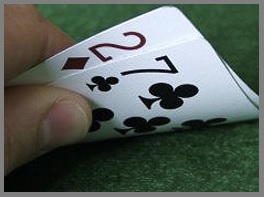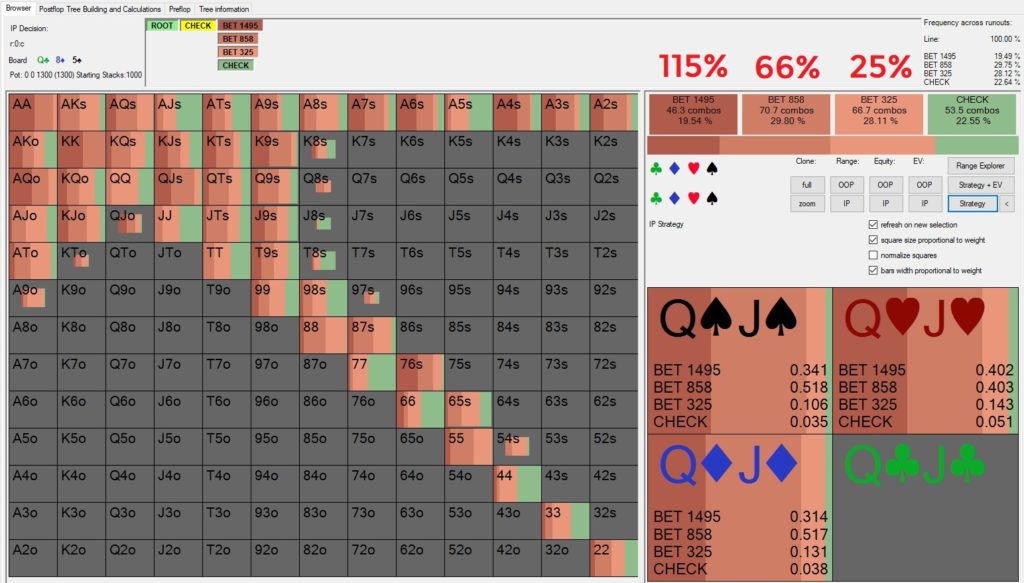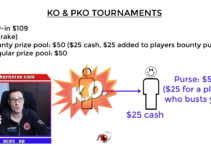An opportunity to win a bounty is what drives the action in a progressive knockout tournament.
The best action can be very different from a regular MTT. So understanding how and when to adjust your strategy is at the heart of winning play.
There are subtle, and not so subtle adjustments astute players are making to win a lot from this popular tournament format. Let’s go through these critical adjustments and unlock the key to PKO tournament success.
If you’re in a confrontation with an opponent and you have a covering stack, it means you have more chips than they do. So if you get all-in against them and bust them, you will win their bounty.

What sort of effect do you suppose a covering stack could have on different actions in the game? Specifically:
♠ Open shoves / preflop all-ins
♠ Opening (RFI) and limping
♠ Calling a raise
♠ 3 betting and re-raising
♠ Defending the blinds

Having a covering stack affects all the decisions we make! We will go through each of these aspects to see why, and how we can adjust correctly to ensure we’re using the best winning PKO strategy!
Open shoves / preflop all-in
Even the simple action of jamming a short stack can be hugely impacted depending on if we cover opponents or not.
In a previous article, titled Progressive Knockout Tournament Strategy, we determined the best way to factor in a bounty was to give it a chip value.
So when you’re all in with an opponent you cover, you can think of it as if you’re playing to win a bigger pot than they are. This allows you to play more aggressively against shorter stacked opponents compared to a regular format MTT.
An exception to this is when significant ICM is present. In PKO tournaments, the influence of ICM is greatly reduced due to the presence of the second prize pool, i.e. the bounty prize pool.
So larger stacks don’t get to assert as much pressure in a PKO tournament as they would in a regular format MTT (our next article release is on this important concept so be sure to keep an eye out for that).
Conversely, when we don’t cover, our deeper stacked opponents in the hand will be calling wider trying to win our bounty. This means fold equity is reduced, so we need to tighten up our jam ranges. Specifically, suited connectors that perform well with fold equity suffer significantly when opponents start calling wider, as they are so infrequently ahead.
So we need to focus our jam range on hands with more raw equity to take advantage of the looser calling ranges of our opponent's.
In the following Video, poker pro Kelvin ‘Acesup’ Beattie discusses jam range adjustments in detail.
[embedyt] https://www.youtube.com/watch?v=rwl4T0zAl9I[/embedyt]
Since opponents are calling us wider when they cover us, and there will be more multi-way confrontations as players jostle for bounties, we need to tighten up our jam ranges when we’re short. Favoring more high card hands that when called by a wide range, have more raw equity compared to suited connectors.
When we cover opponents, we can isolate all-in players wide to try to get heads-up and have the best chance to win their bounty. Learn this important skill in this previous PKO strategy article, Hunting for Bounties in PKO Tournaments.
Although shorter stacked players are jamming tighter, overall all-in ranges will be looser preflop since players will often be bounty hunting with wide ranges. Sometimes players will go wild for a KO! As we see in the following snippet from the $530 Bounty Builder Acesup won on Pokerstars.
Sign-up for the Bounty Hunter Course if you want to see the full review of Acesup taking this tournament down.
Open raising and limping
When it comes to entering the pot for a raise or limp, the number of players you cover at the table significantly impacts how you should play. Currently, PKO Tournament player pools are making consistent mistakes we can benefit from.
Similar to jamming first in, players who don’t cover need to enter the pot tighter. Basically, the fewer players you cover at the table, the less incentive there is to get involved since there's less chance of being able to win a bounty reward. Or no chance if you're the shortest of the active players in a hand!
Moreover, other players will be looking to play aggressively when you enter the pot forcing you to play a stronger selection of hands. Shaving a few percent off a RFI (raise first-in) range is a good adjustment in a lot of scenarios when you're one of the shorter stacks. Here’s look at one such spot where you want to avoid opening a regular format MTT range;
[embedyt] https://www.youtube.com/watch?v=Jdj6YUvG1MQ[/embedyt]
Covering stacks are able to apply pressure to shorter stacked opponents. They can call more liberally and raise to isolate opens significantly wider. This can make limping a viable option.
If you’re considering opening a hand fairly low down in your range that could lead to you being put in an awkward spot if raised, mixing in some limps can give you a better chance of seeing a flop.
You can lose less if you get 2-bet and decide to fold. Or call the 2-bet and take a flop, at what will usually be a more affordable price compared to had you raised. Naturally, you can mix in some stronger hands to keep your play well balanced.
As we saw in the video a moment ago, Acesup limped with pocket aces from early position. Overall, this mode of limping won’t be so common. However, limping with a covering stack will be a play you’ll want to use regularly.
In the following video, Acesup demonstrates the 2 main reasons to limp in a progressive knockout tournament.
As demonstrated, limping is a more viable strategy in PKO tournaments compared to regular MTTs for 2 main reasons:
Firstly, the presence of the bounties incentivizes players with covering stacks to contest more pots. Speculative hands are best for limping and the ideal situation is when short or multiple short-stacked players are on the table which increases the likelihood of knocking someone out.
Limping invests a small amount for great potential gains and allows us to see more flops since 2-bets may still be offering us the right price to continue in the hand considering potential bounty opportunities.
Secondly, limping when there's a short stack on the table often allows us to gain maximum leverage and isolate an all-in player. By considering our hands' power number, the bounty factors in play and the amount of potential dead-money in the pot, we may be able to make some extremely profitable limp-raises. Often resulting in knocking other players out of the hand, leaving us all-in heads-up versus a shorter stacked opponent.
Again, you’ll want to also include some stronger trap hands from time to time to avoid being predictable. This strategy could be especially profitable when used as an over-limp too if you suspect a player is capable of isolating very wide. It's a great play that can allow you to scoop in a huge pot and bounties.
Here’s a classic example of using the limp to create a very favorable situation in a PKO MTT;
[embedyt] https://www.youtube.com/watch?v=oFrNbdlLYyw[/embedyt]
Calling a Raise
The possibility of winning a bounty incentivizes players to get involved in pots. This doesn't mean playing junk hands and getting in some potentially tricky spots that might cost you a lot of chips, but rather you can shift your normal playing range down just a couple of notches. So if in a certain situation you call down to say, 9♥7♥, you might go down to 7♥5♥.
Remember when converted to a chip value, a bounty essentially means you’re getting greater implied odds to play against opponents you cover. This can make speculative hands profitable at times when they definitely wouldn’t be in a regular format MTT.
Balance your calling and raising strategy as you normally would, but overall, look to enter the pot more frequently giving yourself more chances to win bounties.
As opponent’s stacks get shorter, and especially if they have larger bounties, you’ll be targeting them and looking to isolate aggressively which could mean some of your fringier playable hands you sometimes call with, may even be good to raise with.
3 betting and re-raising
The pattern of aggressive play with a covering stack culminates with re-raising.
Deeper stacked opponents should be looking to 3-bet very aggressively, especially when players with less than 30 big blinds enter the pot. Naturally, at this depth, the likelihood of playing for stacks is greatly increased so a bounty reward will frequently be at stake.
As mentioned when we discussed RFI, this aggressive mode of play forces shorter stacks to tighten-up overall. However, when it comes to committing to the pot, shorter stacks may be able to do so looser given they can anticipate players attacking them with wider ranges.
So it’s often a case where you’ll be forced to open tight, then call it off with most or sometimes all of the hands you open with if you’re tested for all your chips.
The adage "open tight get it in light" comes to mind.
To maximize profit in a PKO MTT, covering stacks should be adjusting their ranges significantly to play for bounty rewards. 3-betting medium pairs in a regular MTT for example, versus a 30 big blind middle-position open, could be really borderline or potentially just a bad play.
In knockout tournaments, we see a shift where even the smallest pocket pairs can be making us money. And this presumes the opener has adjusted to the PKO dynamic, which often won’t be the case. More likely, a player will be opening their regular MTT range or perhaps only shaving a few hands off, leaving them even more vulnerable to highly profitable 3-bet attacks.

In the images above taken from the PokerNerve Bounty Hunter Course, Acesup discusses how when opening from MP1 in the left image, he needs to be careful opening too wide with a vulnerable stack since he has 2 start bounties and only M7 (≈20bb). So holding 7♣7♦ it's a really marginal spot.
In the hand on the right, now with a covering stack, Acesup explores a scenario where 3-betting a medium pair in a regular MTT would create a marginal situation. In a PKO MTT however, his pocket eights become a slam dunk 3-bet, and in fact, even 3-betting pocket fours would be profitable! This highlights the different mode of play required to be playing profitably in a progressive knockout tournament.
Of course, you have to also account for the number of players behind and their profiles, how incentivized they are to get involved, and if we cover or don’t cover them. This is something hopefully most readers are doing automatically by now. But if you aren’t, make sure you get in the habit or take the Bounty Hunter Course as it will quickly have you taking the right approach.
Scanning the formation of players and stacks at your table is also especially important when playing from the big blind.
Blind Defense
Good players know a highly profitable big blind strategy is geared around 2 key factors;
♠ Pot odds (and implied odds) - also stay tuned for our soon to be released article on big blind PKO play!
Click on the links if you aren't sure about these topics to make sure you're on the right track when it comes to a good big blind defense strategy.
When bounties are converted to a chip value, we find that our odds and equity realization both increase. Though the pot odds might not be directly affected, the implied odds will be.
Including the bounty amount as part of the potential winnable pot, makes speculating more lucrative. Even some marginal hands like off-suit gappers could become playable against certain player types. Even more so if they have a shorter stack and large bounty reward.
Which brings us to equity realization. The reason why our ability to realize equity is increased is because at each decision point in the hand, we essentially take the approach of adding more chips into the winnable pot to account for the bounty.
This allows covering players to commit opponents more aggressively since they stand to gain more from the pot when they bust an opponent.
More marginal hands and draws will sometimes be getting around the right price to continue when considering the winnable amount in the pot and the players remaining chips. Furthermore, they can often be played aggressively, given the potential bonus that comes into play for committing an opponent to the hand.
These factors combined result in more equity realization, allowing players from the blind to loosen-up when they cover opponents. To prevent some readers from getting out of line the next time they hit the felt in a PKO tournament and are in the big blind looking to get in there with anything, let’s consider a couple of final caveats!
 Firstly, be careful when deep, or when extending your calling range to include trashier hands. For example, at the start of a tournament, the likelihood of busting an opponent is very low given early-stage stack depth. Moreover, negative implied odds are still a thing. So you could end up spewing chips chasing after difficult to attain bounties.
Firstly, be careful when deep, or when extending your calling range to include trashier hands. For example, at the start of a tournament, the likelihood of busting an opponent is very low given early-stage stack depth. Moreover, negative implied odds are still a thing. So you could end up spewing chips chasing after difficult to attain bounties.
This is further emphasized if you’re against a poker pro, as opposed to a recreational player or weaker opponent.
Secondly, keep in mind future bounty EV. If you enter the pot light from the big blind and then lose a small pot getting involved for a bounty chance, it could have deeper reaching implications than you think. If that small pot happens to dip your stack below that of some of your opponents at the table, you’ve lost your covering stack against them.
This is particularly critical to stay tuned in to when you find yourself short but there are even shorter stacked players at the table with hefty bounties in play.
Bleeding even a few chips, such as a call preflop then again facing a c-bet, could reduce your stack just enough to now put the shoe on the other foot. This may make the opponents you once covered at the table the happy recipients of a covering stack they can now use to go for your bounty!
This is especially relevant in today's games since structures are fast and stacks get short quickly. So you have to be super observant to the stacks and bounty factors around you.
Post-flop Considerations
We mentioned previously that equity realization will increase in PKOs. Specifically, when maneuvering post-flop, look to get involved and increase your chance of winning a bounty by adjusting your regular MTT play in the following ways;
♠ Slow play less
♠ Use larger bets
♠ Continue (float) lighter with backdoor equity
Playing hands faster should be an obvious one given the reward for committing a player to the pot. The tricky part is doing so in a way that doesn’t leave your play predictable.
When you’re the aggressor in a hand, if you start firing one-third pot-sized c-bets with marginal hands and three-quarter pot-sized bets when you want to get stacks in with a strong hand so you can commit a player and win a bounty, your play will be easy to read.
The best approach is to consider what sort of bets make sense in a particular spot and then go from there to build a good strategy. So if you’re c-betting after opening UTG versus a big blind defender, it’s going to be hard to incorporate a lot of big bets on dry boards, given your range advantage.
Poker hand simulators like PIOSolver would never advise large bets in that scenario, but there will be a range of situations where big bets are part of a good betting strategy.
An example is on semi-connected boards after you’ve entered the pot from late position and are pitted against a player in the big blind. You can favor a bigger betting strategy and up your betting frequency. So you can build the pot faster with your stronger holdings.
The drawback is, to remain balanced, you’ll want to have bluffs playing the same way and hence may sometimes be putting a lot of money in with a weak hand.

This image shows on a Q♠-8♥-5♣ rainbow flop a player who opened from middle position can often c-bet a large size versus an opponent who defended from the big blind. When offered 25%, 66% or 115% pot size bet options, PIOSolver uses the 115% pot size bet 20% of the time. Players started the hand with around M20 (≈50 big blinds), so by betting big on the flop, there's an increased likelihood of being able to get stacks in by the river. Apply this big betting strategy and even increase the frequency. This will give you the best chance of being able to get stacks in and therefore playing for a bounty reward.
Exploitively, adjust to your opponents. For players thinking multiple levels deep, big bets can also open the door for some meta-game type battles. For example, a large bet might be viewed by your opponent as an attempt to build the pot and play for stacks when you have a really strong hand (depending on the SPR in play).
So it may be that your opponents give you tremendous credit and over-fold to larger bets sizing, making it actually a useful bluff size. In tournaments where player profiles vary considerably, it’s important to be adjusting to your opponents in this way and then using appropriate sizings to achieve your goal for the hand.
This is why understanding SPR, or stack-to-pot-ratio, is such an important concept. Monitor pot size so you can decide the best way to get stacks in if it seems advantageous.
As the preflop non-aggressor in a hand, such as when you call a raise in position or defend the blind, you’ll be continuing with calls and raises more frequently given the incentive to try to win the bounty bonus. The decision to call or raise will usually depend on your opponent profile and their stack. If they are short, getting the money in fast can often be fine, unless they tend to drastically over-bluff.
Here's a spot where Acesup elects to deviate from his normal MTT strategy given the potential bounty reward.
With deeper stacks, you need to be careful forcing the aggression since by doing so, you may give your opponent the opportunity to leverage their stack in a way that forces you to fold, forfeiting any chance of winning the bounty. An example would be when you hold a hand such as a back door straight and flush draw with an overcard, such as Q♠8♠ on a T♠-7♦-4♥ flop.
There’s a lot of favorable turns that can give you a chance to make a nutty hand. Or even a pair, especially the Q, could give you enough of a piece to call down for the bounty against an aggressive opponent’s bets.
If you raise an aggressive opponent on the flop and get re-raised, you’ll typically have to give up the hand.
If you call, you may get lucky and back into a strong hand and win a bounty which may make calling the more profitable option.
The trade-off is, you may be sacrificing some EV by changing your regular profitable strategy - a strategy you may be comfortable using in non-PKO tournaments. In particular, if you are targeting population tendency leaks, you want to avoid deviating too far from your regular strong winning play. It’s likely the same leaks will be present in PKO player pools too that you can take advantage of.
Additionally, it may be that you then have trouble re-calibrating what your range looks like in a PKO MTT if you start varying your regular play a lot. So there’s no need to overdo it, but just be aware of the goal; finding the most profitable way of winning a bounty.
It isn’t always looking to get stacks in fast, especially as you get deeper. Rather, proceed affordably to the next street with a holding that could get lucky and make a really strong, and potentially well-disguised hand. Giving you the chance to beat your opponent by the river and earn a bounty.
 Summary
Summary
The presence of the bounty incentivizes players with a covering stack to get involved. They can open a little wider and utilize limping to play more hands. Conversely, shorter stacks need to tighten up their open-raises and their jam range. Favoring more high card hands, which will perform well against wider covering stack attacks.
Covering stacks loose play should include calling more raises, especially from the big blind given the increased equity realization and adjusted implied odds.
In general, but especially as opponents dip under M12 (≈30 big blinds), covering stacks should be isolating wide to play for bounties. Being able to profitably commit to the pot a few notches weaker, compared to a regular format MTT.
Similarly, post-flop, covering stacks can continue at a higher frequency. The goal is finding the most profitable way of winning a bounty. Sometimes this will include getting the money in fast, at other times, getting a good price and/or closing the action will enable covering stacks to better realize their equity by calling. Giving them a better chance of busting opponents.
The adjustments are fairly intuitive, but the deviation from regular MTT strategy can still be very challenging. It's easy to under-estimate the correct adjustment. Or alternatively, make a costly over adjustment. Not studying covering play theory could lead to some expensive, avoidable blunders.
So be sure to sign-up for PokerNerve's Bounty Hunter Course to become a master of covering stack play. Learn the super fast in-game calculations to factor in bounties, and see over 100 hand examples to ensure you learn how to make the best decision possible, every time.
If you are not ready to jump into PKOs and want to learn the basics of MTT strategies, you can get involved for free with our special deal over at TopPokerValue.com.
Thanks for checking out this article.

If you’d like to hone your skills and become a bounty hunter boss, be sure to check out PokerNerves’s Bounty Hunter Course for more PKO strategy! This includes systems for fast and accurate isolation calculations! Get 25% off the course with coupon code PN25.



